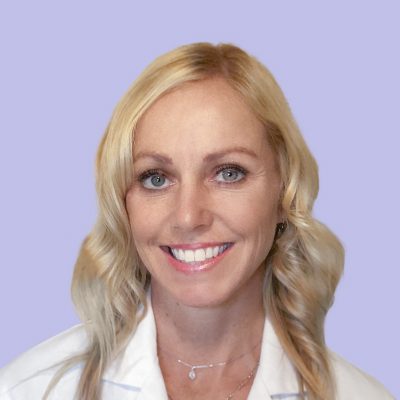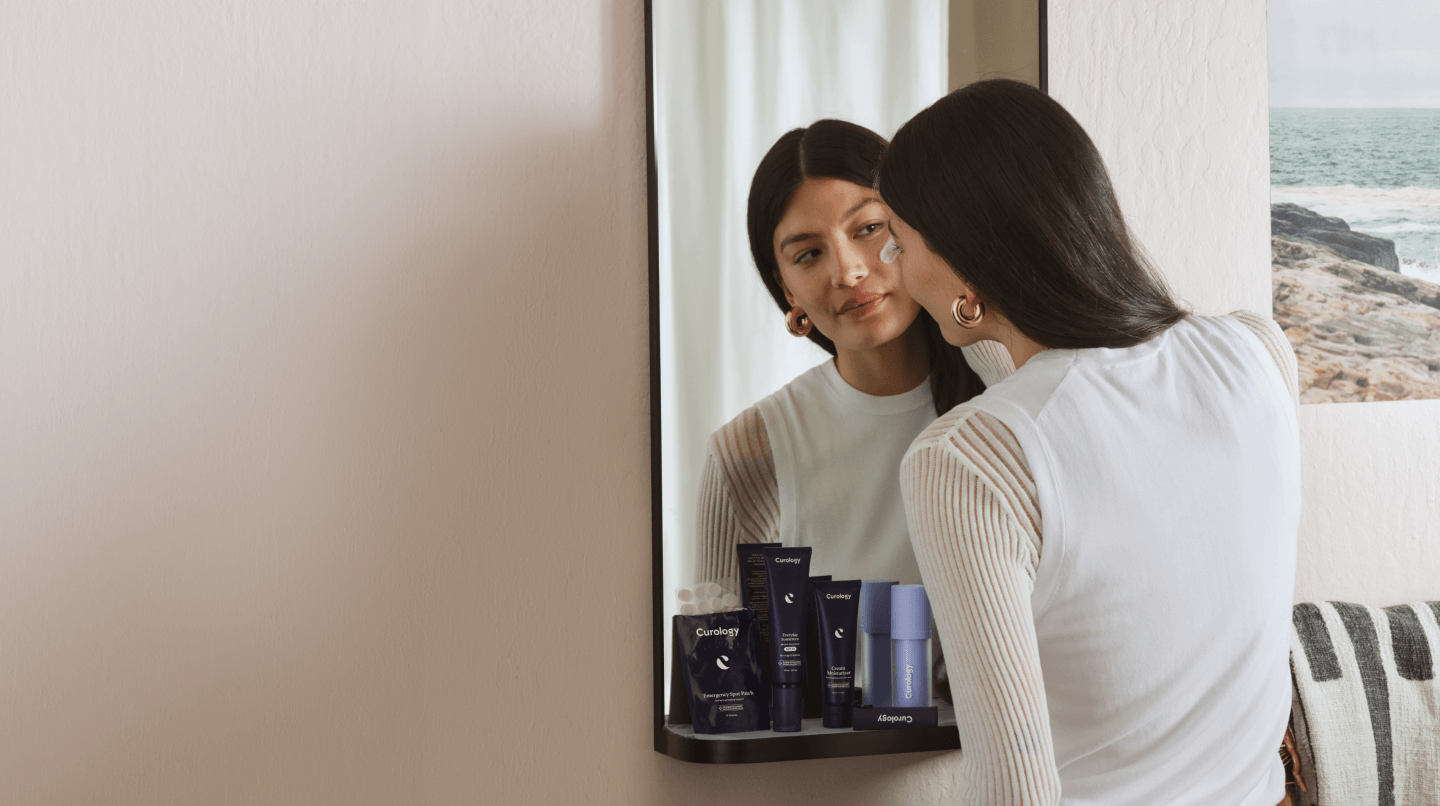How it works:
Share your skin goals and snap selfies
Your dermatology provider prescribes your formula
Apply nightly for happy, healthy skin
How it works:
How it works:
Share your skin goals and snap selfies
Your dermatology provider prescribes your formula
Apply nightly for happy, healthy skin
How it works:
How to help fade age spots on your face
Age spots are a beautiful mark of time passed—but there are ways to help reduce their appearance, should you wish.



If you have small, flat, dark spots on your skin (aka sunspots or age spots), they may happen to be darker or more plentiful than you’d like. If so, the good news is there are things you can do to help make them less noticeable. Age spots are most often your body’s natural response to sun exposure over time. While we think aging is an amazing experience, some people prefer not to show it on their skin—and that’s perfectly okay too.
Here we’ll show you how to improve age spots on your face, what causes them, and how you can treat and help prevent them.
What are age spots?
Age spots, liver spots, sunspots, and solar lentigines are different names for the same thing—small, flat, spots on your skin that are darker than your natural skin tone. Hyperpigmentation is the broader medical term, and it appears when something (often sun exposure, but not always) triggers an increase in melanin production or the number of melanocytes.¹ Melanin is what gives skin its color, and melanocytes are pigment cells that produce melanin. Triggers for increased melanin production include ultraviolet radiation (UV rays), inflammation, and hormonal fluctuations. Age spots are one of the more common types of hyperpigmentation, and they often appear on the hands and face because these areas of skin are frequently exposed to the sun. They take time to develop, which is why they are more common as we get older. But that doesn’t mean young people can’t get them.
Are they age spots or something else?
Age spots aren’t cancerous, nor do they develop into cancer. But if you notice a new spot or bump on your skin, like a changing mole or patch of discoloration, be sure to let your medical provider know. They can help diagnose and treat the spot if indicated.
Along with age spots, seborrheic keratosis and actinic keratosis are conditions that can occur as you age. Here is how to tell the difference between these types of skin spots:
Age spots are typically different shades of brown with a flat texture. They’re often grouped in varying sizes and shapes and are more common in people with lighter skin tones.²
Seborrheic keratosis causes small rough areas of skin to appear slightly raised, with a “stuck-on” appearance, and are yellow to brown in color. Seborrheic keratoses are not harmful.³
Actinic keratosis is often referred to as “pre-cancer.” These spots are typically rough with a sandpaper-like feel and usually appear in areas frequently exposed to the sun, like your hands, arms, and face. Without treatment, these spots can progress to squamous cell carcinoma, a type of skin cancer.⁴
Why do age spots appear on your face?
Because sun exposure is the main culprit of age spots, and your face is almost always exposed to the sun whenever you’re outside, age spots often appear on—you guessed it!—your face. Not all age spots are created equal—some are larger or darker than others. Taking a look at pictures of age spots on the face makes it easy to see how different they can be.

Again, dark spots don’t always happen as a result of sun exposure. They can also develop after the skin heals from an injury, like a cut, or inflammation, like acne. Post-inflammatory hyperpigmentation (PIH) occurs when the skin produces excess melanin in the injured area. While it’s not caused by UV rays, sun exposure can intensify its appearance.⁵
How do you treat age spots?
When it comes to age spots on the face, treatment begins with preventing them from happening in the first place. That means using a broad-spectrum sunscreen with at least SPF 30 every day—even when the sky is overcast. And even though there isn’t a way to get rid of age spots on the face naturally, many natural ingredients can help reduce hyperpigmentation, like licorice extracts, green tea, and turmeric.⁶ And, of course, you can always use concealer to temporarily cover age spots should you wish to do so.
Other proven treatment options include:
Topical anti-aging creams. Active ingredients like azelaic acid, niacinamide, tretinoin (a prescription retinoid), kojic acid, hydroquinone, and tranexamic acid can help brighten your skin and improve the appearance of age spots. At Curology, our favorite prescription topicals include hydroquinone and tretinoin. They work differently, so we may prescribe them for different reasons. If your spots are caused by acne inflammation, Curology’s dermatology providers often recommend tretinoin to their patients, which is also great for treating acne. But if you want to reduce the appearance of age spots, they might prescribe hydroquinone, which blocks the protein required to make melanin. Either way, patience is key. It can take several months before you notice a difference in age spots. (Remember, all good things take time!)
Chemical peels. Alpha-hydroxy acids (AHAs) are chemical exfoliants that remove dead skin cells and boost collagen production. Glycolic acid, citric acid, and lactic acid are popular chemical exfoliants available over the counter. In-office chemical peels work faster, but they can be costly. For a more budget-friendly option, over-the-counter AHAs are worth a try. Just keep in mind that AHAs can leave the skin more sensitive to the sun, so be sure to wear sunscreen and protective clothing when going outside.
Dermabrasion and microdermabrasion. Dermabrasion uses a rapidly spinning brush to “sand” down age spots. It removes both dead and living skin cells. Microdermabrasion does something similar but only removes dead skin cells. Dermabrasion usually takes longer to heal, and as it does, your skin can experience scabbing, redness, and swelling. Conversely, microdermabrasion usually requires more than one treatment completed over several months. Both are in-office resurfacing procedures that should only be performed by a licensed dermatologist or medical provider.
Laser treatments. These are dermatologist treatments for dark spots on the face that uses focused light tuned to a specific wavelength. The skin converts light energy to heat, damaging the unwanted pigment. These procedures typically require multiple sessions.
Your skin is beautiful as is!
At Curology, we believe your skin is part of what makes you uniquely you. We also believe in taking care of your skin with accessible and effective treatments to maintain your skin’s health. When it comes to addressing unwanted dark spots, specifically, we’re all about keeping things simple with a straightforward routine: cleanse, moisturize, and treat—and never skip the sunscreen!
Get your personalized skincare routine with Curology
Get your personalized skincare routine with Curology


Curology helps take the guesswork out of your skincare routine—licensed dermatology providers work with you to examine your skin, assess your skincare goals, and provide custom treatment options. Becoming a member is simple. Just answer a few questions about your skin, and snap a few selfies. If Curology is right for you, one of our licensed dermatology providers will create a personalized prescription formula to address your skincare concerns. You’ll also receive products to complement your treatment plan. We're here for you anytime you have questions.
The first month is free.* Just pay $5.45 (plus tax) to cover shipping and handling.
FAQs
Age spots, liver spots, sunspots, and solar lentigines are different names for the same thing—small, flat, spots on your skin that are darker than your natural skin tone.
Age spots aren’t cancerous, nor do they develop into cancer.
Along with age spots, seborrheic keratosis and actinic keratosis are conditions that can occur as you age. Here is how to tell the difference between these types of skin spots:
Age spots are typically different shades of brown with a flat texture.
Seborrheic keratosis causes small rough areas of skin to appear slightly raised, with a “stuck-on” appearance, and are yellow to brown in color.
Actinic keratosis is often referred to as “pre-cancer.” These spots are typically rough with a sandpaper-like feel and usually appear in areas that are frequently exposed to the sun, like your hands, arms, and face.
Because sun exposure is the main culprit of age spots, and your face is almost always exposed to the sun whenever you’re outside, age spots often appear on—you guessed it!—your face.
P.S. We did the homework so you don’t have to:
Wang, R.F., et al. Disorders of hyperpigmentation. Part I. Pathogenesis and clinical features of common pigmentary disorders. Journal of the American Academy of Dermatology. (2022, February 10).
Plensdorf, Scott, et al. Pigmentation Disorders: Diagnosis and Management.American Family Physician. (2017).
Higgins, James. C., et al. Diagnosing Common Benign Skin Tumors. American Family Physician. (2015).
Salmon, N., et al. Managing actinic keratosis in primary care. Practitioner. (October 2016).
Wang, R.F., et al. Disorders of hyperpigmentation. Part I. Pathogenesis and clinical features of common pigmentary disorders. Journal of the American Academy of Dermatology. Ibid.
Hollinger, J.C., et al. Are natural ingredients effective in the management of hyperpigmentation? A systematic review.The Journal of Clinical and Aesthetic Dermatology. (February 2018).
* Subject to consultation. Subscription is required. Trial is 30 days. Results may vary.

Curology Team

Meredith Hartle, DO
Related Articles
Is washing your face making your acne worse? Ask an expert25 skincare myths debunked: what you need to knowAsk a skin expert: Your skin’s damaged skin barrierPotential side effects of vitamin C: What you need to knowWhat’s causing your skin irritation and how to stop itPopular Articles
Ask Curology: Is my cold breaking me out?Slugging: The dermatologist-approved skincare hack going viral on TikTokTretinoin vs retinol: What’s the difference?How to create a self-care routine that actually sticksYour 2023 skincare horoscopeTry prescription skincare
Get routine essentials


Face what’s next with Future-ProofRx
Face what’s next with Future-ProofRx
- Skin texture
- Fine lines
- Wrinkles
- Dark spots
- Dullness
$29.95/month